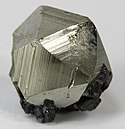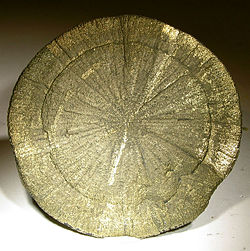Pyrite in cannel coal (Bedford Coal, Middle Pennsylvanian; Noland Tunnel's north portal outcrop, Tunnel Hill, Coshocton County, Ohio, USA) (30551896490)
Pyrite nodule in cannel coal from the Pennsylvanian of Ohio, USA.
Cannel coal is a scarce, fossil spore-rich variety of coal - it is hard and weathering-resistant, has a velvety to satiny luster, little to no stratification, and a conchoidal fracture. The differences in physical characterstics between cannel coal and other ranks of coal (lignite, bituminous, anthracite) are due to the organic matter content. Cannel coals are composed principally of fossil spores (sporinite phytoclasts). Garden-variety coals are composed principally of a mix of altered fragmented plant debris that was originally woody tissue, leaves, bark, fungi, and spores. Cannel coals are generally interpreted to have formed in pond, lagoon, or channel facies within a larger coal swamp setting.
This eastern Ohio sample is from the Bedford Coal in the Pottsville Group, a Pennsylvanian-aged cyclothemic succession containing nonmarine shales, marine shales, siltstones, sandstones, coals, marine limestones, and chert ("flint"). The lower Pottsville dates to the late Early Pennsylvanian. The upper part dates to the early Middle Pennsylvanian. The Lower-Middle Pennsylvanian boundary is apparently somewhere near the Boggs Member (?).
The Bedford Coal occurs just below the Upper Mercer Limestone, which is often a flint-dominated interval. Lithologically, the Bedford ranges from carbonaceous shale to argillaceous coal to bituminous coal to cannel coal. The cannel coal in the Bedford was targeted for mining in the 1800s as a source of fuel. It was particularly useful in the manufacture of kerosene, an illuminating fuel. After the petroleum industry started in the 1860s, production of kerosene from cannel coal essentially ceased.
The sample shown above is not high-quality cannel. The nodule is pyrite. Since collection of the specimen, the nodule has been experiencing pyrite disease - white powder is forming (= iron sulfate).
Stratigraphy: Bedford Coal, upper Pottsville Group, Atokan Stage, lower Middle Pennsylvanian
Locality: Tunnel Hill North Portal Outcrop (= Noland Tunnel's northern portal), ~1.75 air miles north-northeast of the town of Tunnel Hill, western Coshocton County, eastern Ohio, USA (~40° 16’ 33.27” North latitude, ~82° 01’ 53.04” West longitude)
For more info. on cannel coal in general, see:
en.wikipedia.org/wiki/Cannel_coalRelevante Bilder
































Relevante Artikel
PyritPyrit, auch als Schwefelkies oder Eisenkies sowie Katzen- oder Narrengold bekannt, ist ein sehr häufig vorkommendes Mineral aus der Klasse der „Sulfide und Sulfosalze“. Chemisch gesehen ist es die kubische Modifikation des Eisen(II)-disulfids mit der chemischen Zusammensetzung FeS2, besteht also aus Eisen und Schwefel im Stoffmengenverhältnis von 1 : 2. .. weiterlesen
